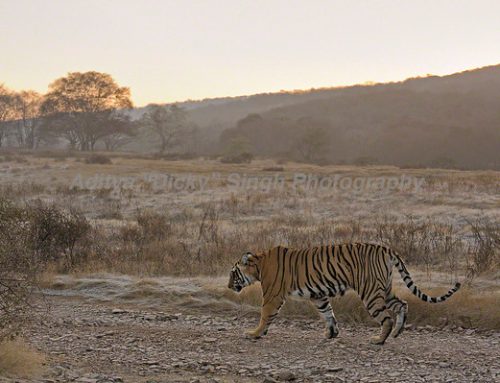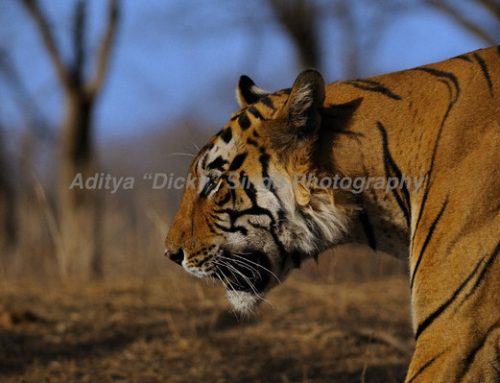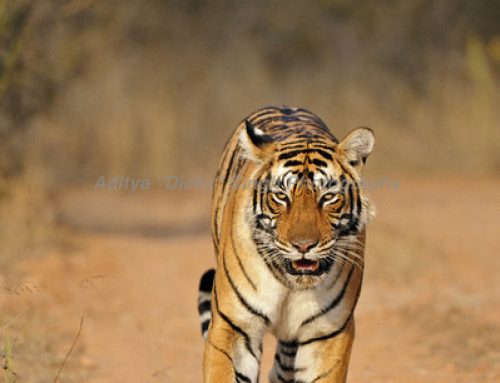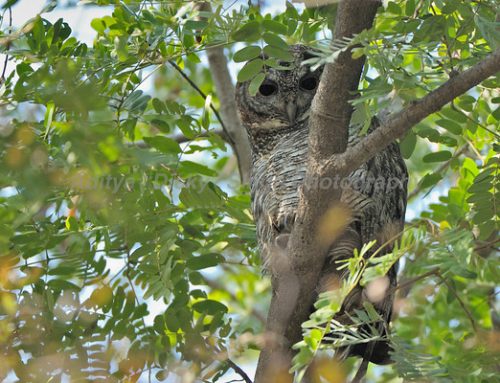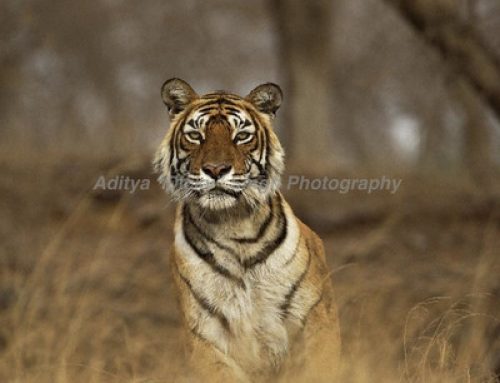The three sisters – “Satara”, “Athara” and “Unnis” (or 17, 18 and 19 in Hindi) were born during the monsoon months (July to September) of 2006. They were the three female cubs of Machali’s (T16) last litter and T 2, who was then the most dominant male of Ranthambhore, was the father. These three cubs (numbered T 17, T 18 and T 19) were first seen, fleetingly and from a distance, by a tourist vehicle in the end of October 2006, when the cubs were really small. However, it was only in December 2006 that we started seeing them regularly. I had my first great sighting of this family in early January 2007 and since then have been seeing them regularly. Right from the beginning T 17 was the dominant one of the three cubs.
When these three cubs were born, Bahadur and Sharmelee, Machali’s male and female cub from the last litter, were still living within Machali’s territory. In other words they were yet to separate from their mother. After these three cubs were born Machali became very intolerant of Sharmelee and would chase her away whenever she found her close to the younger cubs. At the same time she would tolerate Bahadur and would even let him stay in close proximity to the new cubs. Soon Sharmelee took over Lakkarda, which till them was part of Machali’s territory and would rarely cross over to the lakes, where Machali stayed with her younger cubs. Bahadur stayed with Machali and the new cubs for a few months and then drifted off to establish his territory in another part of the park.
During their initial months Machali mostly kept the cubs between the lakes and Nalghati and rarely ventured out of this area. This area has a high density of Sambar deer (India’s largest deer species) and Machali brought these cubs up largely on a diet of Sambar deer. These cubs were born about a year or two after Ranthambhore was badly hit by organized gangs of poachers and the overall tiger density had dropped in Ranthambhore. As a result this family did not have many aggressive neighbors to deal with. Soon after the cubs became slightly bigger she started taking them all over her large territory.
T 17, right from the early days was the dominant litter of this family. By December 2007 she started staying away from the rest of the family for days on end while her other two sisters stayed with the mother. By early 2008, T 17 had established a small territory around the base of the Ranthambhore fort, while her two sisters were still living with their mother. Occasionally T 17 would go back to the family though she was capable of being on her own. By the summers of 2008, T 17 had become totally independent. Her other two sisters took another few months to separate from their mother.
Around the summers of 2008, there was serious moves to “relocate” tigers from Ranthambhore to Sariska (a tiger reserve close by that had lost all its tigers to poaching) and a number of tigers were identified for this relocation – Sharmelee and T 17 were some of them. As part of the process these identified tigers, including T 17, were fitted with a radio collar for tracking them. Sharmelee was relocated to Sariska in early July and Lakkarda area was left open for any tiger to take over. We thought that T 17 or one of her sisters would take this part of the over but this was not to be.

During the winter months of 2008 Satara was fully grown up and confident enough to expand her territory. To everyone’s surprise she started fighting with her mother Machali for Machali’s territory. This war of succession ended in T 17’s favor after Machali left the area of the lakes to establish her base in Lakkarda, where she still lives. Soon T 17 took over most of Machali’s territory except for two small parts – Lakkarda, which was left for Machali and parts of Mandoop, which her sister T 19 took over. Her third sister T 18, had just about established her territory in the Nalghati – Phoota Banda – Phoota Kot area, when she too was relocated to Sariska.
From the end of 2008 till now (beginning of 2012) Satara has been ruling the area of the lakes and large adjoining parts. For the last three years she has been the most frequently sighted tiger in Ranthambhore. Like her mother, Satara is not shy of vehicles and often gets too close for comfort. The only drawback was that she had an ugly (and damaged) radio collar fitted in her neck. This collar was finally taken off in November 2011.
Over the last three years Satara has often mated with four different males but has not had any litter as yet. She always shared her territory with three different males (T 12, T 25 and T 28 earlier, before T 12 was relocated to Sariska and T 24 took over his territory) and this may be the reason she has not had any cubs. During the early summers of 2011, when T 5 – the dominant female of Kachida died of natural causes, Satara started expanding into the Kachida valley, which was T 5’s territory. Right now Satara probably has one of the largest territories amongst all the females in the Ranthambhore national park, a territory rivaled in size only by that of her sister T 19.



